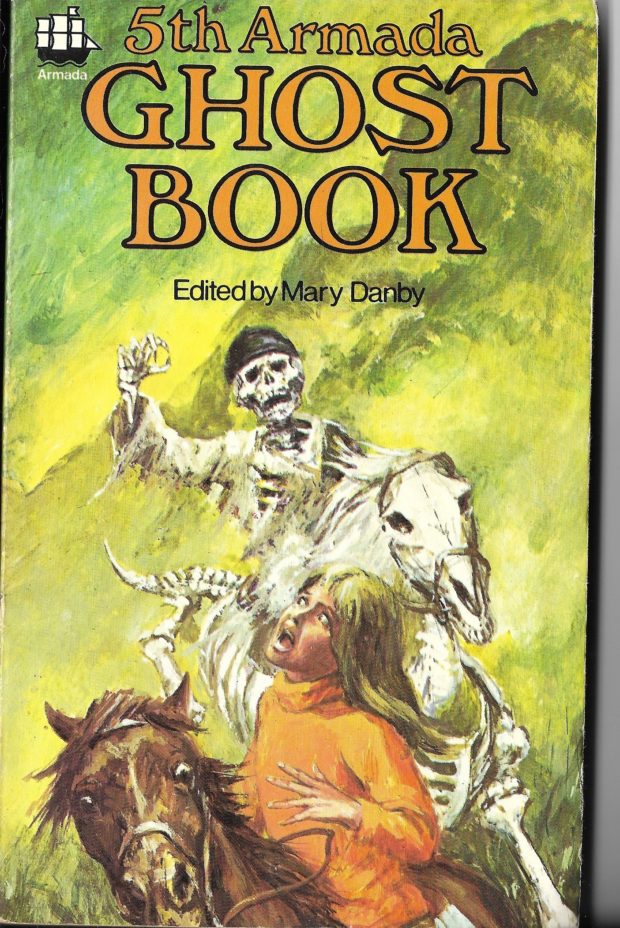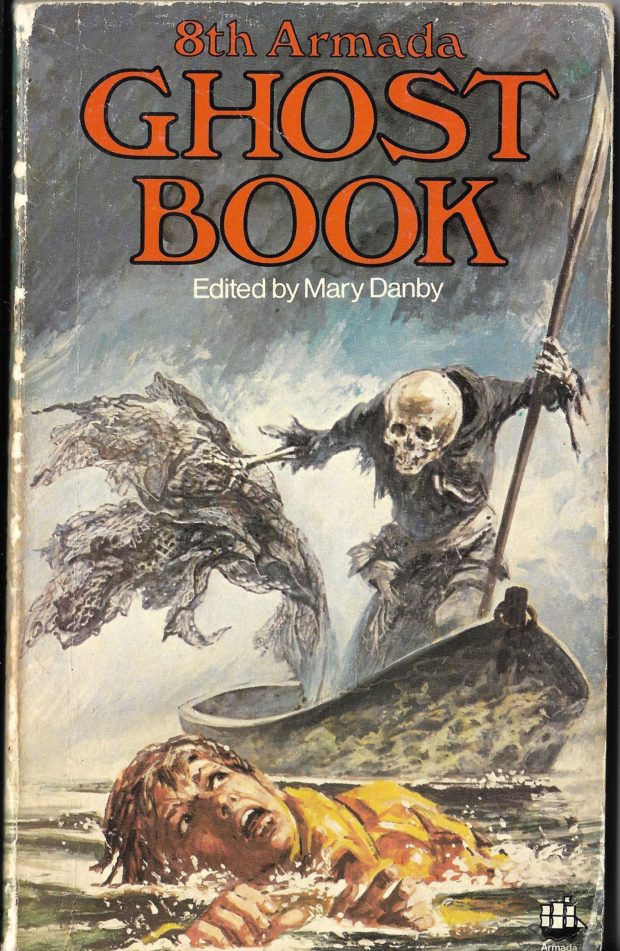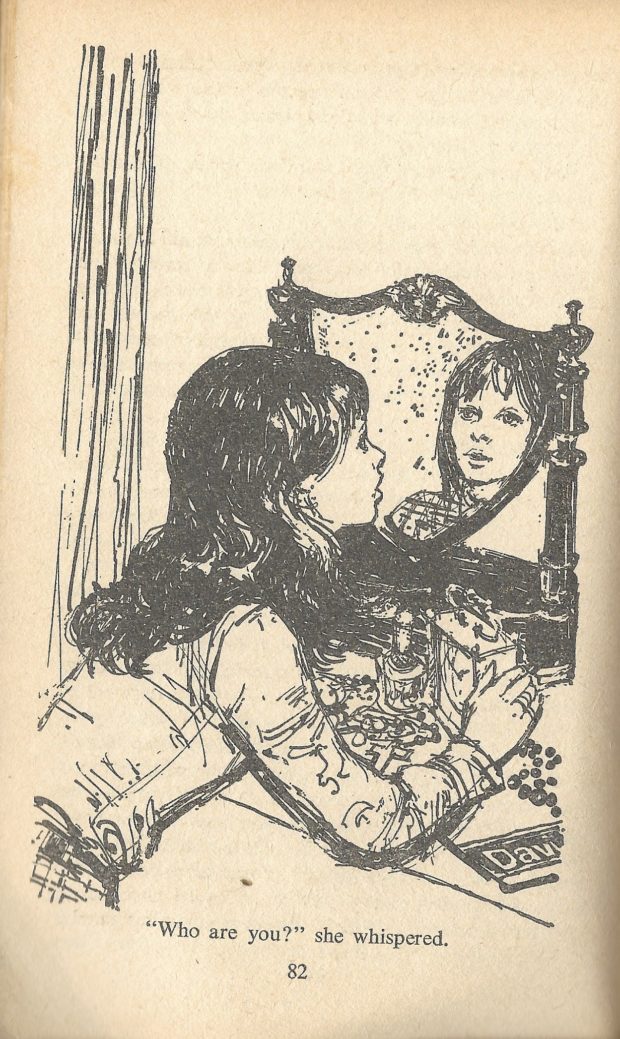You have no items in your cart. Want to get some nice things?
Go shoppingCan a story haunt you? I don’t mean one that spooks you a little, even one that makes you keep the lights on after reading. I’m talking about a story that leaves a scar, an invisible scab that you return to weeks, months, and years after you’d read it. “The Girl in the Mirror” did that to me.
Not that I could even remember the exact title. I knew it was in a collection of ghost stories and there was skeleton on the cover. I would have been ten, in primary school, wooden desks and inkwells still there from earlier generations. In that final year we were given plastic ink pens. We invariably smudged both our books and hands as we wrestled to insert the thin cartridges. Crappy ink pens that would never be used again, that you had to pointlessly master, and would be punished for misusing: that sums up my 1970s education.
Other things though were quite miraculous. Obviously the free milk was gone, and in the next decade they would take our jobs, but that other source of sustenance, the public library, was still in its pomp. The mobile version would park outside our tiny rural village school (thirty pupils); we would line up and take it in turn to step into its cave of treasures. The chosen books would be placed on a shelf in our classroom. I can remember the L-shape of shelves, the large map of the world above. The books from the library were placed in a special area so as not to mix them with the school’s own books: many of which had been in the schools for decades. This was the school that my grandparents, parents, uncles, and cousins had all passed through.
The library service was the only way to get modern books – not that I ever knew when books had been published. I’d worked my way through my mother’s Enid Blyton, published thirty years before, but I knew some books were easier than others to understand.
Who could be haunted by a story? Not a novel, just a story a few pages in length. I don’t think I was particularly sensitive as a child. Sensitivity isn’t a big advantage on a farm. We always had plenty of books though. Not only did the library send its mobile to the schools, it would also stop at the end of my parents’ farm lane so we could walk down and get books. It would make this stop just for the two or three families on that lane.
The library books borrowed by my family were placed in a special place so they wouldn’t get confused with the other books in the house. They were placed on a chair in the spare room, and had to be returned there. My mother didn’t want to search our rooms for them when the library next made its call. Lord of the Flies found its way there one week, but I couldn’t bring myself to pick up the book because of the gruesome cover. Perhaps I was sensitive, but not to real life and death. That pig skull on the cover was somehow more unsettling than the bone fragments scatted over our farm, jaw bones a thin boot-crunch beneath the surface. Death was ever present. Piglets crushed by their mothers, chewed or sickly. Cats drowned in sacks. Chickens torn apart by foxes. Stillbirths. All part of the mix.
Right now, there is much talk about how reading novels generates empathy in the reader. Wouldn’t that be wonderful? The perfect synthesis of silver bullet public-health promotion, and evangelism. No need to learn from life, from loving, from hating, from being hurt or hurting. No need for anger in this sparkling new century. Just read from this list of books. Perhaps that’s why certain books are frowned upon – if it’s so easy to bestow empathy via books, then surely other, darker emotions can be conjured by the act of reading. And perhaps they should be.

When my son was around eight I read him The Tiger Rising (by Kate Dicamillo). A wonderful book, but (spoiler) the tiger dies. The ending takes me by surprise too, but he’s old enough to deal with this, isn’t he? The real world doesn’t always run smoothly.
Not all stories have happy endings, I tell my son, nestled on the bed beside me. Surely, that was right. Wasn’t it fair to warn him?
His bottom lip quivers. His eyes are huge. My heart drops through the floor. What have I done?
“How many don’t?” was his very reasonable question.
How could I possibly answer that? My brain raced through all the stories with less than upbeat endings. Too many.
“Three,” I squeak.
“Then we won’t read those,” he said.
And that was the end of the matter.
Had I told my son a story that would haunt him?
I’m happy to report he seems undisturbed as a teenager, and quite relishes a less-than-happy ending. The Tiger Rising, a book that deals with rage and injustice, which let me introduce Blake to my son, is also a book about a beautiful tiger that is killed.
What was it about “The Girl in the Mirror” that had it slipping round and round in my head for years? I didn’t have the book. I never went back and reread it, but it never left me. I have more memories of thinking about that story, dreading it, then I do of reading it. Books weren’t a thing for conversation. We could talk about comics. What superhero could beat another, etc. – and then, later, all our talk was of music, never stories. Who would have spoken about such a thing? If you read, you kept it to yourself.
As the years passed all I had was my memory of that story, and the ghostly horseman on the book’s cover. I also remembered the first story in the anthology was called “Pride Comes before a Fall” (actually it wasn’t, but I had the memory that it was). That cover, that title, and the story of “The Girl in the Mirror”niggled at the edge of my brain for years.
Decades go by, and the Internet is here. In the intervening years, I have looked for the book in second-hand bookshops, but mostly it has faded to a memory of something not-quite-right. When I do mention the story (by now I know people I can talk about books with) it sounds almost Freudian. A time-travel story. Two girls switch places through a magic mirror. One girl, rich and lazy, is from the present; the other is a hardworking girl on a Victorian farm.
The rich girl wants to swap places, live on a real farm to ride the horses. To avoid detection they will leave their clothes behind for the other. The rich one goes through the mirror first, meets the brutal parents, and of course is trapped there. It’s that image of nakedness, vulnerability, and being trapped in an alien world that unsettled me. The girl from the Victorian farm slips into the future and is never seen again. Smart girl. When I told my partner about this story that had so freaked me she thought it probably didn’t exist. That it was something I’d created. After thirty years of films, comics, books by the thousand, how many could remain with you? My psychedelically enhanced synapses had embellished and transformed something I’d heard, read, or seen into a memory.
It is a time-travel story, not a ghost story. One person is trapped on a farm forever. Perhaps this story, lodged in my brain, influenced my decision to refuse the farm when offered a few years later. But that’s hindsight. We create a coherent narrative after the events, refusing to believe that life is random.
But that story was real. I was sure of that, despite having had the experience, several times over my life, where things I “remembered” have been disproved by family, or myself. I’ve learnt that memory can’t always be trusted. I might not remember something, might think I’d locked a door, or sent an email, when really I hadn’t, but my brain was unlikely to create something as elaborate as“The Girl in the Mirror” to haunt myself with.

The story that haunted me for so long is short and not collected in other anthologies. It is no classic. Its author, Margot Arnold (born 1925) is still alive and has spent her life writing books such as The Officer’s Woman, Marie, Voodoo Queen, and Lament for a Lady Laird.
It wasn’t through the Internet that I tracked the book down. I searched and found the Armada book of Ghost Stories, the one with that cover, and ordered it. When it arrived, there was no “The Girl in the Mirror”. It did have “The Skeleton Rider”,in which a character is warned “Pride comes before a fall”.
I didn’t doubt the existence of the mirror story, but clearly my memories were jumbled. For decades I’d assumed if I just found that book with that cover, I would have the story. There were other books in that series, and other similar anthologies. I bought a couple at random but none had my story. I got on with my life. Moved house again. Back into the countryside, though Shropshire rather than Yorkshire.
Here I could make paper boats and float them in the stream with my son. You needed to make your own entertainment here. It was perfect for wandering. I expected my son to have that anchorless roaming existence I had had, but there was no dog, and he wasn’t constantly being told to get out of the house, so never developed the habit. People in the village muttered about child snatchers, men in white vans. I thought of my childhood when Hindley and Brady had prowled and preyed. That had never stopped any of my parents’ generation telling their kids to get out and get fresh air – get out of their house. The Bogey Man only gets you if you stray from the path. In the twenty-first century there is no safe path.
One afternoon, we are sitting by the river, and there is the inevitable church stall of bric-a-brac, junk, books, and food. I checked out the stalls. You can see the ending, can’t you? And it’s true, there it was: The 8th Armada Ghost Book. There were several of the series. I picked them up, knew immediately which one held “The Girl in the Mirror”, recognised the black and white illustrations, the seventies hairstyles.
To be honest I felt quite sick finding it again. Motion sickness, as if the world had lurched the wrong way. I tried to force myself to read the story but something wouldn’t let me. The words remained black letters. It was enough that I had the story, the book.
And it sat on the shelf for a couple more years, until I finally picked it up and read the story through. It is short and exactly as I remember it. There is no reason that story should have lodged so tightly in my brain. I have read so many ghost stories, horror stories in my life – have a whole collection, but that fairly crappy one stuck in my brain, and in some small unseen ways changed my life.
We are not empty vessels. We cannot accurately predict what reading one book or story will achieve. Or that we will get the same results each time. These are not laboratory conditions. We are not rats. We are readers, and have our own stories.

About David Kendall
David Kendall is a writer, workshop facilitator, and co-director of Penned Up - a literature festival organised with, and for, those in prison. He edited the anthologies The Mammoth Book of Zombie Comics, and The Mammoth Book of Best War Comics.
- Web |
- More Posts(1)





I’ve just finished reading this story but I’m not sure I agree the character Belinda survived her journey into the 1970s. There’s mention of an unexplained heap of dust found in Jennifer’s room which made me assume that for some reason she had crumbled into dust whereas Jennifer apparently took her place permanently in Victorian times and ended up locked in the attic. Not sure why one should survive but not the other but that’s the impression I got.